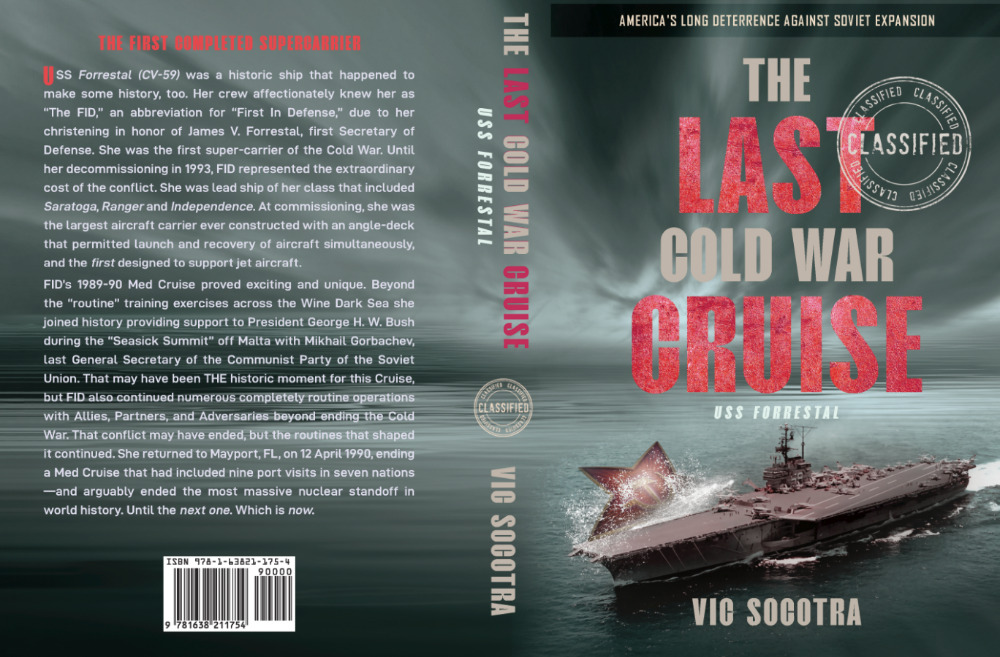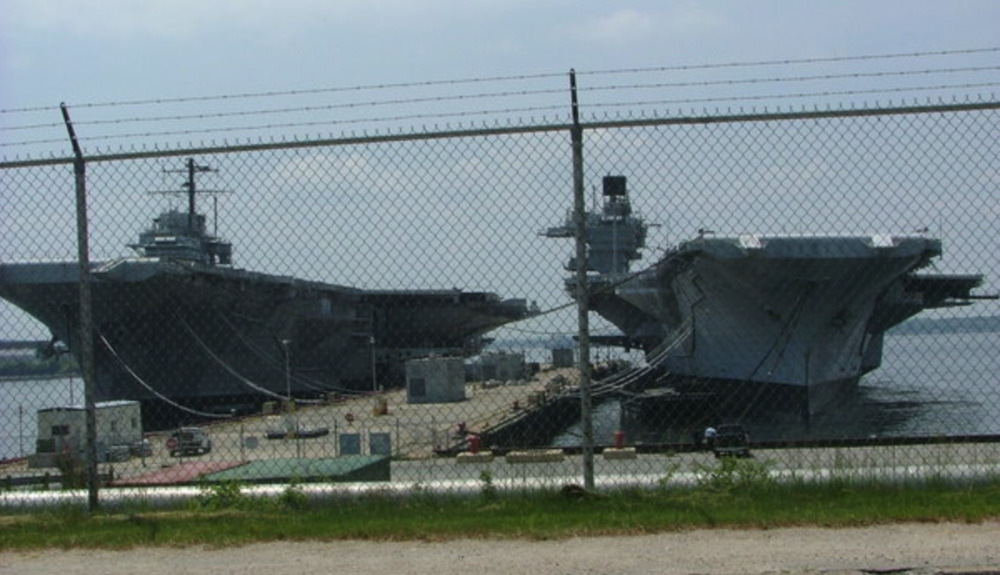Going to Press

(This was the big deal yesterday- the cover to the manuscript of “Last Cruise.” It includes the teaser description for the back cover, a semi-dramatic symbolic image of a mighty warship steaming in the vicinity of an imaginary symbol of an implacable foe for the front. We think we got it complete, after the initial attempt that featured too many “words” on the back, since the ISBN numbers had to fit on the little white box at the bottom. The technical end of publishing is more complicated than one would think. It is so complex a process that it won’t see actual print for another few weeks!)
We got up this morning to wave our hands in the air around the Fire Ring. Some of them, the hands, that is, clutched cigarettes in the “V” shape formed by the inner two long fingers. The Chairman prohibited indoor smoking several years ago, and that was part of the story we sent via satellite to a semi-square state out in the Southwest quadrant of our great nation. There was mild jubilation, since the manuscript had been proofed all through 468 pages, which sounds big, but reflect the two or three format changes to get it all presented with images and slightly flashy chapter breaks.
The questions from the production Lady brought back memories. Like ISBN numbers. The abbreviation stands for “International Standard Book Number,” and helps us keep our production at Socotra House in order and subject to traceable copyrights. An ISBN contains 10 digits in length, or did up to the end of December 2006. Since January 1st, 2007, they now consist of 13 digits. We purchased ten ISBN’s at that length to ensure we were ready for the publishing future, since the ship we rode at the time was decommissioned in 1993, just 36 months after we returned from the 1989-90 cruise that Ended the Cold War.
The story is sort of interesting completely aside from the World Historical Impact of ending a conflict that had dramatically re-drawn the old maps that featured European Empires and Royal Families. When we were getting ready to deploy to Homer’s Wine Dark Sea, we became a symbol of progress and innovation. Not that we were particularly progressive or innovative. Coming behind us in the Navy’s scheme to resolutely confront the Soviets in the Med was a modern aircraft carrier, powered by nuclear reactors and with a state-of-the-art Air Wing. The deployment of USS Eisenhower, named for the President who defined the 1950s in America.
Of course, timing is everything, and our boat, USS Forrestal (CV-59), happened to be in the right place at the right time. Of course, IKE is still afloat and operating and you might have shaved with blades forged from the steel that used to steam around the globe powered by conventional fossil fuel.

(This 1993 image may look like USS Forrestal (CV-59) at left, USS Saratoga (CV-60) on right. They are actually both decommissioned former warships awaiting a tow from this pier in Rhode Island down to Texas to be broken into manageable chunks for disposal).
An old Navy tradition includes creation of a Cruise Book to celebrate completion of assigned missions by the ships and crews that accomplished them. Some of the unpleasant aspects are naturally minimized or erased. Plus, no crew and no ship are ready to roll out of the rack in the morning and decide to cross an ocean or two, hurling hulking jets off the front end and accepting their return at the stern. There is normally a period of vigorous training, months in length, called “work ups.” We did ours in 1989 aboard CV-59 down in the Caribbean, assigned to Air Wing SIX. We were scheduled to conduct a routine deployment from Jacksonville, Florida to the Mediterranean Sea, a link in the unbroken cycle of deployments to that body of water 45 years in length.
There is an official Navy account of the deployment, since a Big Deal occurred just after our arrival in the Med, passing through the Strait of Gibraltar. We were assigned to be a back-drop to the end of a major conflict that cost trillions of dollars back when a “trillion” actually was a lot of cash.
Since we knew the official account would be prim and proper, we vowed to record the events of the cruise as they actually occurred. Along the way, the leaders of the Soviet Union and United States decided to meet on ships near the island state of Malta and end the long Cold War. As part of a low-key conclusion designed not to be an embarrassment to the Russian side, USS Forrestal (CV-59) became a historic ship that happened to also make history.
She was an intrinsic part of the long struggle. Forrestal was the first operational super-carrier. She was lead ship of her class of four proud ships: Forrestal, Saratoga, Ranger and Independence. At the commissioning, she became the largest aircraft carrier ever constructed, and the first designed to support jet aircraft. Her crew affectionately knew her as “The FID,” an abbreviation for “First In Defense,” due to her christening in honor of James V. Forrestal, first Secretary of Defense in the great national security restructuring of 1947. She was a year younger than some of us who rode her, so she had a certain familiarity. Despite a major fire that delayed departure from Florida, she got underway for points east on 06 November 1989 for her turn in the long string of deployments that continue today. Some of these words appear on the back cover of the book that is now on the way to the printer, or the number generator if you prefer an eBook version.
Here is an assortment of the words selected to appear on the volume we hope with be glossy and attractive, stimulating sales:
“FID’s 1989 Med Cruise proved exciting and unique. Beyond the “routine” training exercises across the Wine Dark Sea she joined history providing support to President George H. W. Bush during the “Seasick Summit” off Malta with Mikhail Gorbachev, last General Secretary of the Communist Party of the Soviet Union.”
That was THE historic moment for a Cruise, but FID also continued numerous completely routine and complicated operations with Allies, Partners, and Adversaries beyond ending the Cold War. That conflict may have ended, or better said, we thought it ended, but the routines that shaped the voyage were vast and continued.
We returned to Mayport, FL, on 12 April 1990, ending a Med Cruise that had included nine port visits in seven nations- and arguably ended the most massive nuclear standoff in world history. We became inured to the possibility of global destruction, and thought Peace might be breaking out. It seemed that was a good idea at the time, thirty years ago.
As sailors, we just shrugged and said “Until the next one, of course!” And now that Peace is a little tattered, we find ourselves confronting the possibility that we are back to square one. We hope not. But of course, we are just retired sailors and intend to stay ashore for this part of the adventure.
Copyright 2022 Vic Socotra
www.vicsocotra.com
